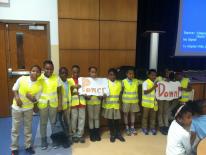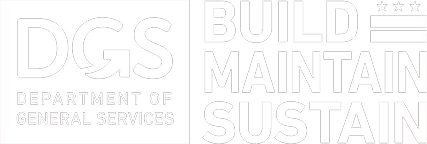
After a successful first year, the Department of General Services, in collaboration with its partner organizations, is running its second Sprint to Savings energy reduction competition at DC Public Schools. Twenty-six schools, or almost a quarter of DCPS portfolio, are participating.
More so perhaps, than installing new boilers, the competition is a fun, effective way to engage our schools and raise energy awareness. It not only produces energy savings--during last February's three-week Sprint, 28 schools saved 76,000 kilowatt-hours of electricity, enough to power seven American households for nearly an entire year-- but provides students with educational and leadership opportunities. With scores of local professionals volunteering to support teachers, students and building staff in identifying saving opportunities, it also exposes our students to a fast-growing, local green-economy.
But beyond the educational benefits, occupant engagement is a critical tool DGS needs to continue to utilize in order to meet ambitious energy and carbon reduction goals. Through Sustainable DC and other initiatives, the District has committed to reducing energy consumption and carbon emissions 20 percent by 2020 and 50 percent by 2032 against a 2012 baseline. The Healthy Schools Act of 2010 mandates these reductions are achieved even sooner at DCPS schools. As the agency responsible for operating and managing these buildings, DGS is legally bound to comply with these progressive sustainability goals and mandates. However, DGS can’t meet these goals alone. It will require the combined efforts of DGS as the facility operator and DCPS as the facility occupants.
A robust occupant engagement program will complement the Department of General Services’ other nationally recognized efforts to green the DCPS school portfolio. These efforts, described in more detail below, include construction and modernization of school buildings; improvements in energy efficiency; wide-scale deployment and utilization of renewable energy; and, a district-wide waste reduction program. Combined, these efforts will lower DCPS utility costs—currently around $30 million annually, reduce its carbon footprint and create a more healthful learning environment.
Construction
DGS leads the DCPS schools modernization and stabilization process, a $3.2 billion, 15-year investment in improving our school facilities. A key component of the modernization process is constructing sustainable “green” buildings. These buildings use less energy and water, but just as importantly, create more conducive, healthful learning environments that utilize natural light and improve indoor air quality. To date, DCPS schools have earned 17 LEED certifications and an additional 19 schools are in the process of being LEED certified. In addition, these facilities have earned over 50 locally and nationally recognized awards for design excellence. You can learn more about the modernization process on the DGS School Projects webpage.
Energy efficiency
DGS's energy efficiency program is based on an unprecedented data acquisition initiative that captures a building’s energy use in 15-minute intervals. The granular data makes it easier to identify saving opportunities and prioritize cost-effective interventions such as building retrofits, operational improvements and lighting upgrades. Furthermore, in an effort to be a national leader in transparency, the information has been made publicly available on an easy-to-use website: BuildSmartDC.com. Using this data and energy audits, DGS is aggressively targeting sites that have high savings, low cost opportunities. Last year, energy efficiency improved by 5.8 percent across the DGS portfolio, including schools, municipal buildings, fire stations and other publicly owned buildings. At certain sites, efficiency gains exceeded 20 percent. At some of our largest building, the cost savings were in the six figures.
Renewable energy
The Department of General Services, Energy and Sustainability Division, has spearheaded a massive renewable energy scale up for public buildings and installed numerous green technologies including geothermal, solar, wind and more. In 2013, the District signed its first-ever power purchase agreement, an innovative financing model that lowers energy costs and reduces risk for the city, for a 463-kilowatt solar panel installation at Dunbar High School. It’s now the largest solar rooftop array in the city. DGS has since scaled up its solar efforts and is in the final stages of procuring a 10-megawatt solar power purchase agreement that will place solar photovoltaic panels at 40 additional schools. (See Attachment A.1, Master Summary and Bundling List of the RFP solicitation)
To put in perspective, New York City, which has 13 times as many public school buildings as DC, has less than 1-megawatt of solar power currently installed at its schools. The District is also negotiating a cutting edge wind power purchase agreement (PPA) that will be among the first of utility-scale energy purchases by municipalities. The wind PPA is anticipated to provide approximately 120,000 to 150,000 megawatt hours of electricity on an annual basis--roughly 35 percent of the District’s energy consumption. Together, these projects not only decarbonize the District’s energy supply, but also lower cost and reduce risk against volatile energy prices.
Waste reduction, recycling and composting
DGS runs the DCPS Recycles! Program designed to fulfill legal requirements; improve building operations; reduce waste of money and natural resources; achieve the Sustainable DC target of zero waste by 2032; and teach DCPS students values and skills for a sustainable 21st century. Currently, all DCPS schools are included in the mandatory recycling program and 55 schools are slated to begin receiving supplies and services for recycling organics in cafeterias and kitchens by the end of this school year.
